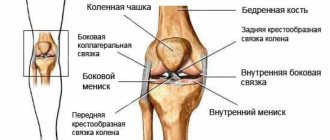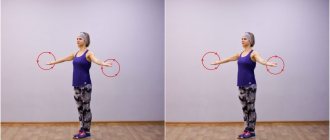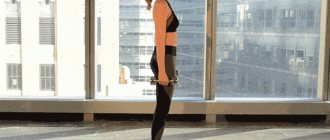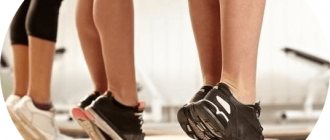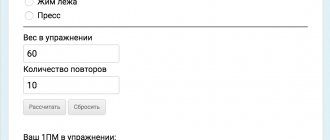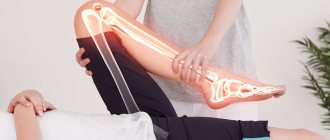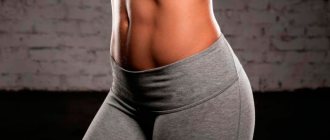- Head tilts.
Flexibility is a critical parameter that is often forgotten. It is this that determines the capabilities of a person’s muscles and its development. With flexible, elastic muscles, the body becomes much faster and stronger in everyday life. Any physical activity can be overcome with ease.
But with age or in the absence of appropriate training, a person becomes less flexible, the muscles seem to become stiff, which negatively affects movements and even posture. In this case, when creating an exercise program for losing weight in the thighs, lower or upper abs and other parts of the body, it is necessary to use elements to improve flexibility.
Why you need to develop flexibility
Elastic muscles and flexibility of the whole body are not only physical development, but also the health of the body as a whole:
- A sedentary lifestyle and constant use of the computer leads to stagnation in the circulatory system, back pain and muscle tension, which negatively affects the functioning of the spine. Performing stretching, even the most basic, allows you to restore blood flow and start all the most important processes in the body.
- Constantly tense muscles increase the risk of injury several times. With more flexible and mobile joints, the risk of various injuries is sharply reduced.
- It has been scientifically proven that the lack of elasticity and flexibility of muscle fibers negatively affects a person’s emotional state. Exercises for stretching the back and other parts of the body relieve not only stiffness, but also stress and moral tension.
If you have led a sedentary lifestyle for many years, the results of stretching will be visible after just a few sessions.
What factors influence the development of flexibility?
The main factors influencing the development of flexibility:
- anatomical structure of joints;
- shape and area of joints;
- structure of ligaments and tendons;
- characteristics of the muscles involved;
- the state of the nerve centers responsible for muscle tone;
- gender and age;
- heredity;
- muscle temperature;
- time of day;
- type of previous activity, etc.
The rhythm of the exercises is of particular importance. Rhythm allows you to maintain muscle excitability at a certain level, which will have a positive effect on their elasticity. Failure to comply with the rhythm will lead to a decrease in muscle elasticity.
How to stretch correctly
Before starting the training process, there are several important points to consider:
- We start each lesson with a warm-up. To do this, it is enough to perform a couple of simple movements, for example, jumping rope, running in place. The purpose of the warm-up is to warm up the muscles, normalize blood circulation, and prepare the body directly for the main program.
- We perform all elements of the program slowly, without rushing. Rushing in this case can lead to unpleasant consequences in the form of muscle damage.
- It is important to maintain regularity. We conduct training at least four times weekly. Only regularity and diligence can improve the condition of the muscles, restoring their elasticity and mobility.
- We divide the set of exercises into specific blocks, united by some parameter. Ideally, it is divided into three main groups: for the back, legs and shoulder girdle/arms.
Abdominal stretching exercises
1. Lie down on the floor, place your palms as if you are about to do push-ups.
2. While applying force to your arms, straighten them completely at the elbows, at this time the chest and abdominal muscles lift off the surface.
3. Stay in this position for up to 10 seconds, feeling the stretch in your abdominal muscles, then lower yourself to the floor and relax your abs to relieve the feeling of tension and go up again, do this 4-5 times.
1. Take the starting position - feet slightly wider than shoulder-width apart, for stability, hands on your sides on your belt.
2. Lifting your left hand from your belt, lift it up and tilt it to the right until you feel tension in your oblique abdominal muscles.
3. Feeling the entire left side being pulled, immediately return to the starting position and do the same with your right hand. Remember, when you stretch, you don’t need to linger, stretch as hard as possible and immediately back, this is enough for the muscles to get a decent stretch.
Head tilts
This exercise can easily be classified as a warm-up exercise, but when you do it, you will quickly understand how effective it is in increasing elasticity. The technique is simple:
- We take a standing position - we place our legs at a short distance from each other, our arms are lowered along the body.
- We do an exercise - we alternately tilt our heads in different directions. The choice of direction is determined individually: clockwise or counterclockwise, with alternating sides.
Wrist movements
If you have pain in the arms, you definitely can’t do without this exercise:
- We take the starting position as in the previous element.
- We raise our arms to the sides.
- In this position, we begin to slowly rotate our hands in different directions.
- One cycle consists of several rotations. Then we relax and repeat again.
Note. The “arm rotation” exercise is performed in the same starting position. In this case, we make the movement not with the hands, but with the entire limb.
Development of flexibility in children of senior preschool age
In addition to the exercises already given, children 6-7 years old will benefit from elements that will not only develop plasticity, but also reduce the risk of injury during training.
After all, as Marcus Tullius Cicero said: “Grace and beauty cannot be separated from health.”
Elements that are recommended to complete any training can be the following:
- the preschooler kneels down, puts his hands behind his back and crosses his hands into a lock at the level of the pelvis, then you need to smoothly move your hands back;
- you need to extend your left arm to the right, touching your right shoulder, the right arm should be bent, creating a support for the left elbow, then you need to bend your left arm and place it on your right shoulder;
- repeat the same for the other hand;
- the child kneels and rests his hands on the floor, with his hands turned inward, then he should smoothly lean back until he feels tension in his biceps and forearms;
- we place our left hand behind our back over our shoulder, while our right hand should push our left elbow even further behind our back;
- the same element for the other hand;
- from a lying position on your back with your legs extended, you need to lift one leg up and clasp it with your hands, the goal is to smoothly pull the limb towards your head;
- repeat the element for the other leg;
- we sit down and spread our legs to the sides, walking forward with our hands along the floor, trying to lay our body on the floor;
- from a lying position, you need to pull your knees to your chest, clasp them with your hands and carefully pull them to your shoulders, then roll forward and backward.
Twist
This movement belongs to a set of exercises with a gymnastic stick. If this equipment is not at hand, you can take any oblong object (even a rolled up large towel will do). Technique:
- We take a vertical position. We take the equipment in our hands with a wide grip.
- We pull our arms completely straight up, then twist the shoulder joints back, pulling them together with the stick.
- We do the required number of repetitions.
Helpful advice. To get the desired effect, we gradually complicate the exercise. To do this, you need to reduce the grip distance with your hands.
Chest stretching exercises
1. This exercise is called scissors - stand straight, legs slightly wider than shoulder-width apart, spread your arms to the sides and sharply bring your arms in front of you, with your right hand first on top (as in Figure B), then force your arms back, feeling a stretch in your chest and again brings his left hand in front of him, but on top.
2. Continuing to alternate arms in front with arms extended back, stretch the pectoral muscles.
1. An exercise from the old Soviet school is also a good idea: first bend your elbows, spread them to the side so that your forearms are parallel to the floor and push your arms back with your elbows bent.
2. Then, returning to the starting position, spread your arms again, but with your palms up.
3. Alternately perform a push of the arms back with bent elbows and a fly with the arms straightened.
There is one more wonderful exercise. Stand in the doorway, arms bent at the elbows, placed to the side and rest your palms on the baseboards on the sides of the door, elbows should be slightly below shoulder level. Next, leaning forward, we stretch the pectoral muscles, lightly rocking back and forth.
Side bends
This is one of the highly effective exercises for stretching muscle fibers. It is performed as follows:
- We stand up straight, placing our hands on our sides.
- Pull one arm up, fully straightened. We move it to the side, simultaneously tilting the body and moving as if under the action of a spring.
- Next, we take the starting position, change hands, and repeat the exercise in the other direction the required number of times.
Daily stretching exercises will make you flexible in 6 weeks
Hip flexor stretch: Start on your knees, then extend your left leg back onto your toes, lifting your heel off the floor. Focus on your left hand, place it parallel to your right leg, bent at the knee. Rotate your torso toward your right knee and raise your right arm upward, directing your gaze upward. Hold this position for 30 seconds, then switch sides.
On the muscles of the inner thighs: Spread your legs wide apart, tighten your core muscles and lower yourself lower to your feet, trying not to bend your knees. For beginners: Cross your arms and let them hang freely, resting on the floor. For an advanced level : reach the fingers of your left hand to the toes of your right foot, and the fingers of your right hand to the toes of your left foot. Hold the pose for 30 seconds.
Side stretch: Extend your leg to the side and bend the other one towards you. Bend over your extended leg, keeping your shoulders straight. Hold for 30 seconds, change sides and then legs.
Runner Stretch: Start on your knees, extend your left leg forward, and place your palms on either side of your shins on the floor. Feel as if you are pushing your spine towards your stomach, this will help keep your back straight. Hold for 30 seconds, change legs.
Calves + peroneus: While seated, extend one leg forward with the foot of the other leg resting on your knee.
The hand opposite the extended foot reaches toward the big toe, repositioning the foot so that it points slightly inward. Sit up straight, pushing your lower back toward your core to maintain good posture. Hold for 30 seconds, change legs.
Swing your legs
Flexibility and elasticity are important not only in the arms and torso. Legs also need to be trained. With this exercise you will quickly restore muscle tone:
- We stand sideways to the support, leaning our hand on it. It could be a chair, a machine, a table. The main condition is that the equipment must be placed at waist level. Otherwise, there will be no effect from execution.
- We swing with a leg that is not blocked by a support.
- First we make movements back and forth, then sideways.
- We change position - we rest on the other side, and repeat the movement the required number of times with the other leg.
Development of flexibility in schoolchildren
The exercises described below are intended to develop flexibility in children of primary school age, but are also suitable for teenagers.
They help to significantly develop flexibility and reduce the risk of injury during training:
- Kneeling, the child should put his hands behind his back and cross his hands into a lock at the level of the pelvis. After this, the arms bent at the hands are smoothly moved back.
- In a standing position, you need to tilt your head forward, as if you are trying to reach something with your chin. With your right hand, grab your head from above so that you can reach the tip of your left ear with your fingers. After this, the head is tilted to the right (to be on the safe side, you should help yourself with your hand). Next, the exercise must be repeated in a mirror manner.
- The child should extend his left arm forward and to the right in the same plane as his shoulder. The right arm should be bent and placed so as to create a support for the left elbow. Next, the left hand is bent and placed on the right shoulder. Make sure that the left one is at the same level with the shoulder.
- The child should straighten his left arm and extend it forward with his palm facing inward. Lower it in front of you to shoulder level. The right hand should be used as a support, applying light pressure to the left elbow. Next, the exercise should be repeated, changing hands.
- You need to spread your arms to the sides at shoulder level and bend them at right angles at the elbows, pointing your forearms forward and your palms down. The shoulders should be rotated so that the forearms are parallel to the body, but make sure that the elbows do not go out of the plane of the shoulders. You should turn your shoulders as much as possible.
- The child should kneel down and rest his hands on the floor, turning his hands inward. After this, you need to start leaning back until you feel a slight tension in your forearms and biceps.
- The right hand is placed behind the back over the top so that the palm is located just below the middle of the collar area and the elbow is above the right ear. The child should raise his left hand above his head so that the back of the hand rests on the elbow of his right hand. Use your left hand to press down on your elbow until tension occurs in your right triceps.
- Lying on your back, stretch out your nails. The left one rises up and needs to be grasped with the left hand below the knee, and with the right hand slightly above. Next, the child should begin to smoothly pull his leg toward his head.
- In a lying position, the child needs to pull his knees to his chest and clasp them with both hands, and then he should begin to gently pull them towards his shoulders. You can raise your head, trying to touch your chest with your chin. Next, the child should smoothly roll forward and backward several times.
- You need to lie on the floor, as before doing push-ups, and slowly push up from the floor, bending your torso and without lifting your legs and pelvis from the base.
Interesting facts about flexibility
By putting together a full set of exercises to develop flexibility, your body will experience a huge positive impact from such physical activity. It would seem that these are simple elements, but what is the effect as a result. If you're still wondering whether or not to include these exercises in your training program, be sure to check out these interesting facts about flexibility:
- The mobility of the joints of the human body develops up to 14 years of age. By the age of 17, complete stabilization occurs. Then the regression begins.
- Before 9 am the body is less flexible than at other times. But it is during this time frame that the benefits of performing the appropriate exercises are higher.
- As the temperature rises, the flexibility of the body increases. When it goes down, it decreases.
- Due to anatomical features, women are much easier to do longitudinal splits. Men sit on the transverse one faster and easier.
- The flexibility of the right and left sides of the body is significantly different.
- The effectiveness of stretching is felt after just 30 seconds of performing the appropriate exercises.

